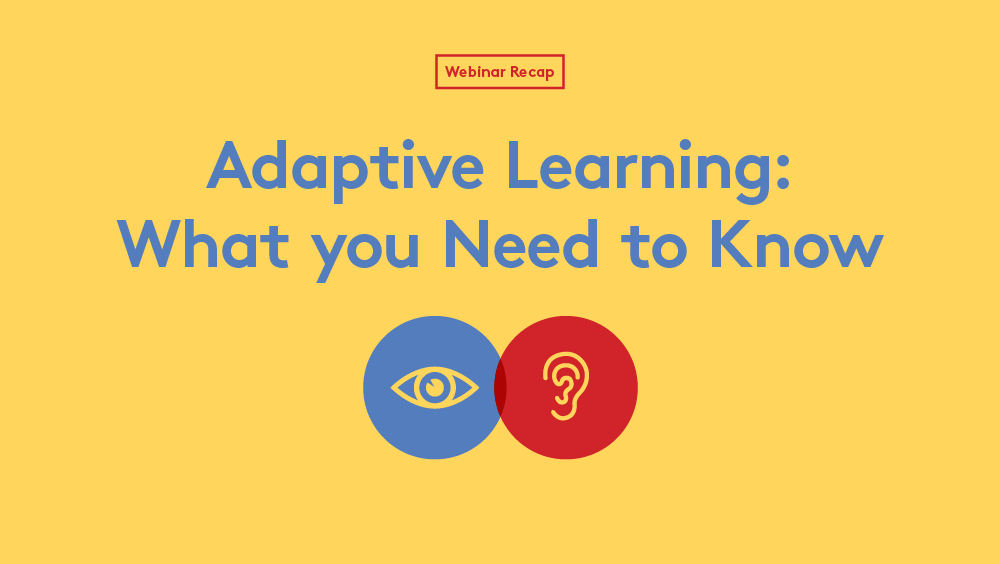
Webinar Recap: What You Need To Know About Adaptive Learning
We recently hosted a webinar featuring our friend, Ben Paris, Director of Learning and Assessment at Second Avenue Learning and an adaptive learning expert. In this thirty-minute webinar, Ben discussed the basics of adaptive learning – how it works, why it works and the types of learning that benefit most from this methodology.
Ben began his discussion by defining adaptive learning as:
“If something is adaptive, it takes in some kind of data, like data from learners, and then uses it to provide different experiences for different people.”
When it comes to the question of “why should an organization incorporate adaptive learning?” Ben’s explanation as simple: learners are different, so their learning experiences shouldn’t be the same.
Learner Differences
That begs the question: how are learners different? And while we all know that no two learners are the same, we might not be able to quantify how they’re different. According to Ben, there are a few actionable factors that differentiate learners, like:
- Initial skills and knowledge – Learners enter the learning environment with different levels of knowledge. One learner might have deep expertise and mastery, while another is new to his or her role and therefore needs more training.
- Time constraints –There is no one set pace for learning. Learners seek a pace that’s appropriate for their knowledge level or dedicated time to learn.
- Interest and ambition – Not every learner goes into the learning experience with the same goals. Some learners may just want to pass the minimum requirements, while others may be more motivated to challenge themselves and deeply learn the content.
- Other preferences – Things like technical know-how and requirements (e.g. learners must have the right technology to play a video) or partiality to a particular teaching style or instructor might further define a learner.
This list demonstrates why a learning department might want to shift learners’ experiences based on their differences.
How adaptive systems adapt
Next, Ben delved into the “how” portion of the webinar – how systems can adapt based on learner differences. Here he offered three main methods:
- More objectives, or fewer – Adaptive systems can offer more content or less content. If a learner already knows the content, there is no point in teaching it again, but if the content is new to the learner, he or she might need more exposure to it.
- More depth, or less – Based on knowledge, interest and preferences, learners might require more or less depth of content. For example, within a math course, learners are asked questions about percentages. If a learner struggles with the percentages questions, but get the rest of the math content correct, chances are they just need a reminder. But if the learner gets the percentages questions wrong along with rest of the math content as well, they probably need a deeper, more detailed account of the content.
- Different paths to the same objective – Just because there is one learning objective, doesn’t mean that each learner has to follow the same learning path. Adaptive learning can incorporate particularly effective teaching styles and media preferences that impact the learning and offer a variety of learning paths.
Different adaptive approaches
After covering how adaptive learning works, Ben turned his attention to adaptive approaches – how adaptive systems decide what and how much content learners need?
- Gap Analysis – Measuring where each learner has gaps within the whole of the content.
- Adapting with Objects – Adapting the learning object itself using branching to make content modifications as a learner progresses through the learning.
- Adapting among Objectives – Giving learners more or less content at varying depths depending on knowledge and interest.
- Crowdsourcing – Allowing other learners to provide recommendations for what learning gets priority, rather than a computer deciding, lets learners leverage the opinions of previous users to get an idea of the learning path they’d like to follows
Requirements for Adaptive
Once Ben covered what adaptive learning is, how it works and how it adapts, he touched on the requirements necessary for creating adaptive learning. Here’s Ben’s list of requirements:
- Content – All content assets that any learner might possibly see
- Metadata – Organizing system with information about the learning assets/objectives (e.g. Blooms level)
- Logic – A mechanism to evaluates the metadata and assessment answers and inform who gets what content experiences
- Assessment – The questions!
- Technology – Technology that integrates all of the above to get the right content to the right learners at scale (and with much less effort).
When adaptive is most effective
Finally, Ben talked through scenarios for when adaptive learning is most effective. He reiterated that it’s ideal in instances where initial competences are highly varied – where some learners have more base knowledge while others have less. It’s also great for content that’s hierarchical and is most effective when assessments can be quick and precise. (Ben recommends that only 20-25% of learning should be spent in assessment.) Finally, adaptive learning is a good method when there are meaningfully different ways to teach and where learners have different goals for their learning experience because an adaptive system can be more responsive to these differences.
We’re grateful to Ben Paris for sharing his adaptive expertise and practical experience with our webinar participants. For more information about how Fulcrum Labs approaches adaptive learning, click here.
